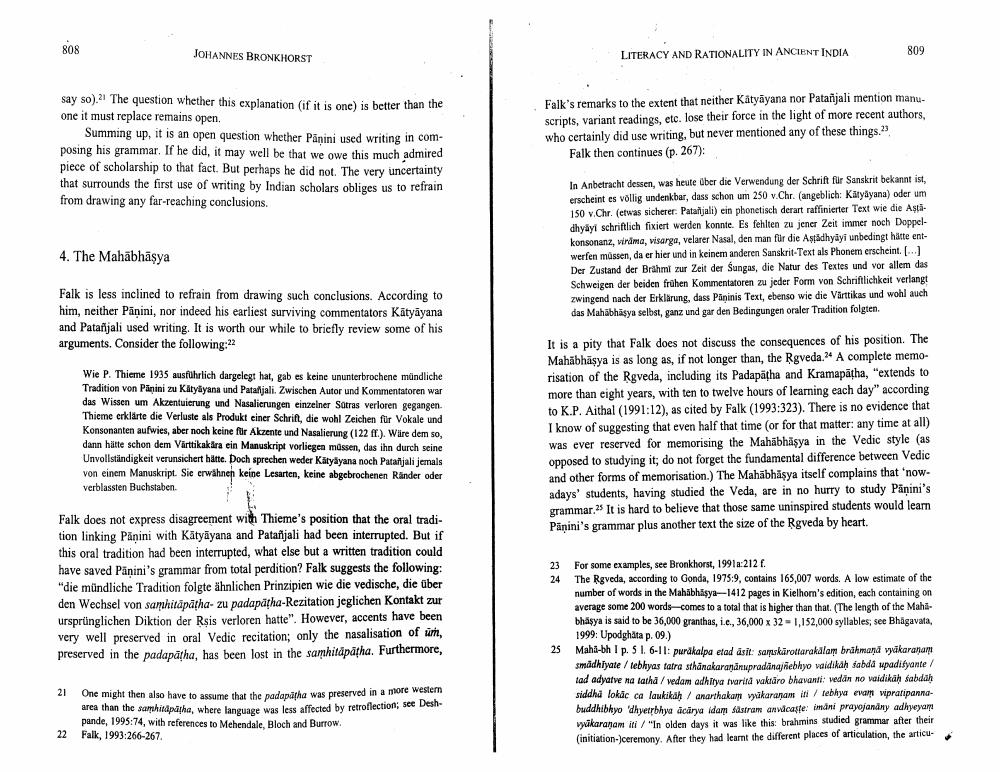Book Title: Literacy And Rationality In Ancient India Author(s): Johannes Bronkhorst Publisher: Johannes Bronkhorst View full book textPage 7
________________ 808 say so).21 The question whether this explanation (if it is one) is better than the one it must replace remains open. Summing up, it is an open question whether Panini used writing in composing his grammar. If he did, it may well be that we owe this much admired piece of scholarship to that fact. But perhaps he did not. The very uncertainty that surrounds the first use of writing by Indian scholars obliges us to refrain from drawing any far-reaching conclusions. JOHANNES BRONKHORST 4. The Mahabhāṣya Falk is less inclined to refrain from drawing such conclusions. According to him, neither Panini, nor indeed his earliest surviving commentators Katyayana and Patanjali used writing. It is worth our while to briefly review some of his arguments. Consider the following:22 21 Falk does not express disagreement with Thieme's position that the oral tradition linking Panini with Katyayana and Patanjali had been interrupted. But if this oral tradition had been interrupted, what else but a written tradition could have saved Pänini's grammar from total perdition? Falk suggests the following: "die mündliche Tradition folgte ähnlichen Prinzipien wie die vedische, die über den Wechsel von samhitapatha- zu padapatha-Rezitation jeglichen Kontakt zur ursprünglichen Diktion der Rṣis verloren hatte". However, accents have been very well preserved in oral Vedic recitation; only the nasalisation of um, preserved in the padapatha, has been lost in the samhitäpätha. Furthermore, 22 Wie P. Thieme 1935 ausführlich dargelegt hat, gab es keine ununterbrochene mündliche Tradition von Panini zu Kätyäyana und Patanjali. Zwischen Autor und Kommentatoren war das Wissen um Akzentuierung und Nasalierungen einzelner Satras verloren gegangen. Thieme erklärte die Verluste als Produkt einer Schrift, die wohl Zeichen für Vokale und Konsonanten aufwies, aber noch keine für Akzente und Nasalierung (122 ff.). Wäre dem so, dann hätte schon dem Värttikakära ein Manuskript vorliegen müssen, das ihn durch seine Unvollständigkeit verunsichert hätte. Doch sprechen weder Kätyäyana noch Patanjali jemals von einem Manuskript. Sie erwähnen keine Lesarten, keine abgebrochenen Ränder oder verblassten Buchstaben. One might then also have to assume that the padapatha was preserved in a more western area than the samhitapatha, where language was less affected by retroflection; see Deshpande, 1995:74, with references to Mehendale, Bloch and Burrow. Falk, 1993:266-267. LITERACY AND RATIONALITY IN ANCIENT INDIA Falk's remarks to the extent that neither Katyayana nor Patanjali mention manuscripts, variant readings, etc. lose their force in the light of more recent authors, who certainly did use writing, but never mentioned any of these things.23 Falk then continues (p. 267): 23 24 809 25 It is a pity that Falk does not discuss the consequences of his position. The Mahābhāṣya is as long as, if not longer than, the Rgveda.24 A complete memorisation of the Rgveda, including its Padapatha and Kramapaṭha, "extends to more than eight years, with ten to twelve hours of learning each day" according to K.P. Aithal (1991:12), as cited by Falk (1993:323). There is no evidence that I know of suggesting that even half that time (or for that matter: any time at all) was ever reserved for memorising the Mahabhäşya in the Vedic style (as opposed to studying it; do not forget the fundamental difference between Vedic and other forms of memorisation.) The Mahabhāṣya itself complains that 'nowadays' students, having studied the Veda, are in no hurry to study Panini's grammar. 25 It is hard to believe that those same uninspired students would learn Panini's grammar plus another text the size of the Rgveda by heart. In Anbetracht dessen, was heute über die Verwendung der Schrift für Sanskrit bekannt ist, erscheint es völlig undenkbar, dass schon um 250 v.Chr. (angeblich: Katyayana) oder um 150 v.Chr. (etwas sicherer. Patanjali) ein phonetisch derart raffinierter Text wie die Aştădhyayi schriftlich fixiert werden konnte. Es fehlten zu jener Zeit immer noch Doppelkonsonanz, viräma, visarga, velarer Nasal, den man für die Astädhyāyi unbedingt hätte entwerfen müssen, da er hier und in keinem anderen Sanskrit-Text als Phonem erscheint. [...] Der Zustand der Brahmi zur Zeit der Sungas, die Natur des Textes und vor allem das Schweigen der beiden frühen Kommentatoren zu jeder Form von Schriftlichkeit verlangt zwingend nach der Erklärung, dass Paninis Text, ebenso wie die Värttikas und wohl auch das Mahabhasya selbst, ganz und gar den Bedingungen oraler Tradition folgten. For some examples, see Bronkhorst, 1991a:212 f. The Rgveda, according to Gonda, 1975:9, contains 165,007 words. A low estimate of the number of words in the Mahabhaṣya-1412 pages in Kielhorn's edition, each containing on average some 200 words-comes to a total that is higher than that. (The length of the Mahibhasya is said to be 36,000 granthas, i.e., 36,000 x 32= 1,152,000 syllables; see Bhagavata, 1999: Upodghata p. 09.) Maha-bh I p. 51. 6-11: puräkalpa etad āsīt: samskārottarakālam brāhmaṇā vyākaraṇam smādhiyate/tebhyas tatra sthanakaranänupradanajñebhyo vaidikaḥ sabda upadifyante/ tad adyatve na tatha / vedam adhitya tvaritä vaktāro bhavanti: vedän no vaidikaḥ sabdaḥ siddhā lokāc ca laukikäḥ / anarthakam vyäkaranam iti / tebhya evam vipratipannabuddhibhyo 'dhyetṛbhya ācārya idam sastram anväcaste: imani prayojanany adhyeyam vyakaranam iti / "In olden days it was like this: brahmins studied grammar after their (initiation-)ceremony. After they had learnt the different places of articulation, the articuPage Navigation
1 ... 5 6 7 8 9 10 11 12 13 14 15 16 17 18
